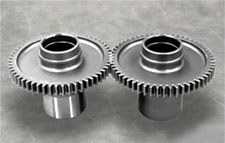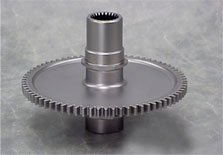

Spur Gears Manufacturer
The Designer is confronted with the problem of transferring power from one shaft to another while maintaining a define ratio between te velocities of rotation of the shafts. Various types of gearing have been developed for this purpose which will operate quietly and with very low friction losses. Smooth and vibrationless action is secured by giving the proper geometric shape to the outline of the teeth. The proportions of the gear tooth, as well as the sizes of the teeth, have been standardized. This procedure has simplified design calculations and has reduced the required number of cutting tools to a minimum. The proper material must be selected to obtain satisfactory strength, fatigue, and wear properties. Ease pof manufacture and ease of inspection are necessary if production costs are to be kept at their lowest level. All these problems must be taken into account by the designer. Bending Capacity of Spur Gear Teeth It
is possible, when two meshing gears have large numbers of teeth, for several pairs
to be in contact simultaneously. It is customary, however,to assume that the entire
load is carried by a single pair and that the load is acting through the corner
or most unfavourable point on the tooth .This tooth load causes bending stresses
in the material. |

